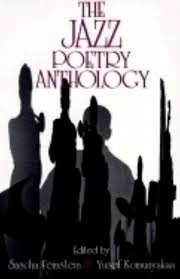
On The Bookshelf
The Jazz Poetry Anthology
Since the turn of the century, poets have responded to jazz in all its musical and cultural overtones. The poems here cover the range of jazz itself: from early blues to free jazz and experimental music. Among the 132 poets included are James Baldwin, Lawrence Ferlinghetti, Langston Hughes, Jack Kerouac, Mina Loy, Ishmael Reed, Sonia Sanchez, Amiri Baraka, Carol Bergé, Sterling A. Brown, Alice Fulton, and Carl Sandburg.
The poems give the reader a sense of jazz imagery through the history of the music, yet have been lost to so many jazz enthusiasts and aficionados of the 20th century. Many of the names in this publication will be familiar but most one will discover anew.
Each poet has heard, felt the emotion of and experienced the music from a different perspective, writing in that voice. This makes for a pleasurable journey through time for the reader, especially those familiar with the music and the musicians.
This anthology represents the broad appreciation for jazz as poetic inspiration, not only from the Beat movement but from writers across the decades and around the world.
The Jazz Poetry Anthology: 1991 | Sasha Feinstein & Yusef Komunyakaa
Indiana University Press
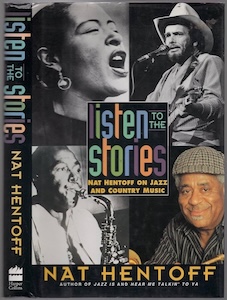
On The Bookshelf
Listen To The Stories
Nat Hentoff has been listening to jazz, blues, country, and gospel since he was eight years old and tuned in (under the bedsheets) to Fats Waller broadcasting from Chicago’s Hotel Sherman during the Depression – and he has been writing about it nearly ever since, with ever-increasing passion.
This new book is the fruit of long nights of listening to, watching, traveling and talking with, and knowing firsthand jazz musicians and country and gospel singers from all over the nation – a book of truly American originals.
In this 220 page collection of stories he writes poignant descriptions of the early days of Roy Eldridge, the last years of Billie Holiday and Bird. He chronicles accounts of Duke, the Count, and Dizzy. Listen to the Stories covers new recordings and old legends, remarkable lives and unforgettable music.
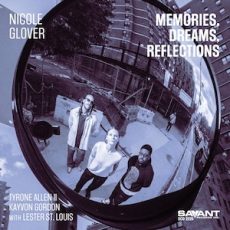
Daily Dose Of Jazz…
Nicole Glover was born on July 18, 1991 in Portland, Oregon. Her musical journey began when her father introduced her to improvised music at a young age. She started playing the clarinet at the age of ten, transitioning to tenor saxophone the following year. Her interest and curiosity for music blossomed in high school, becoming involved in a variety of performance groups, both within her school and in the community.
Nicole was chosen to be one of nineteen students from across the nation for the Next Generation Jazz Orchestra, who embarked on a national tour that involved performances with Bobby Watson and Julian Lage, and concluded with a performance at the Monterey Jazz Festival with Wynton Marsalis.
After studying at William Paterson University, in 2011 Nicole returned to Portland where she was invited to record on Esperanza Spaulding’s Grammy-award winning album Radio Music Society. She now performs in multiple groups with multi-instrumentalist George Colligan, as well as her own jazz trio and several other improvisational ensembles, such as, the Alan Jones Storyline Sextet, Thomas Barber’s Spiral Road, and the Kerry Politzer Quintet.
2015 saw Glover releasing her debut album First Record, featuring pianist and trumpeter George Colligan, bassist Jonathan Lakey and drummer Alan Jones. She leads her own trio with bassist Tyrone Allen II and drummer Kayvon Gordon. This was followed with the release of Plays, and HighNote-Savant Records Memories, Dreams, Reflections.
Throughout her musical career, Nicole has performed with Mulgrew Miller, Esperanza Spalding, Kenny Garrett, George Colligan, Geoffrey Keezer, Bennie Maupin, Bobby Watson, Mike Clark, Carl Allen, Kenny Washington, Al Foster, Victor Lewis, Lenny White, Joe Farnsworth, Reggie Workman, Dee Dee Bridgewater, Ben Wolfe, Bill Stewart, Essiet Essiet, Mel Brown, Julian Lage, Obo Addy, Rob Scheps, Red Holloway, Terell Stafford, Helen Sung, Dana Hall, Scotty Barnhart, and Thara Memory, to name a few.
Glover is a member of Ural Thomas and Pain, Artemis led by Renee Rosnes, Ursa Major led by Christian McBride, and has toured with Jazz at Lincoln Center Orchestra.Tenor saxophonist, bandleader, composer, and educator Nicole Glover, who is on faculty at the Manhattan School of Music and has taught masterclasses and private lessons to students around the world, continues to fit performance in her busy schedule.
More Posts: bandleader,educator,history,instrumental,jazz,music,saxophone
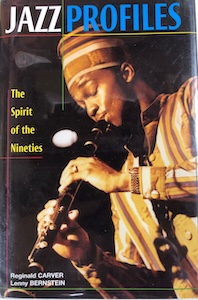
On The Bookshelf
Jazz historian Reginald Carter and jazz photographer Lenny Bernstein present an introduction to the young lions of jazz. Most of these musicians have decided to forgo post-1960s jazz developments, instead mining the treasures of the bop/hard-bop masters. The profiles include a short biography, photo notes, a wonderful black-and-white photograph, recent interview excerpts, and a select discography.
The artists’ thoughts on the upswing in jazz’s popularity and on balancing performing, composing, and recording, provide an overall sense of where these musicians find themselves within the jazz culture.
Arranged according to instrumental groupings, the book features such musicians as Terence Blanchard, Roy Hargrove, Wynton Marsalis, Nicholas Payton, Wallace Roney, Branford Marsalis, James Carter, Joshua Redman, Bobby Watson, Don Byron, Craig Handy, Steve Turre, Bill Frisell, Russell Malone, Geri Allen, Cyrus Chestnut, Marcus Roberts, Christian McBride, Reginald Veal, Cindy Blackman, Jeff “Tain” Watts, and vocalists Dee Dee Bridgewater and Kevin Mahogany.
In this compendium we see those forty musicians who have individually taken the music to its evolutionary continuance.
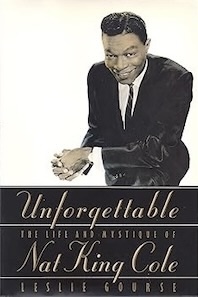
On The Bookshelf
Unforgettable: The Life And Mystique Of Nat King Cole | Leslie Gourse
Very few may know that Nat King Cole, born March 17, 1919 in Montgomery, Alabama began his musical career as a groundbreaking jazz pianist. His trio was untraditional with an upright bass and guitar. This was long before he ever achieved stardom with his velvety-smooth vocals on songs like Nature Boy, L-O-V-E, and of course, Unforgettable.
Leslie Gourse’s claim that his keyboard style prefigured bebop and influenced pianist Ahmad Jamal is debatable. However, Gourse does a fine job of documenting the influence of Cole’s second wife, Maria Ellington, who urged him to pursue a more lucrative singing career. Although he did not win the favor of 1950s radical Negro activists, Cole’s personal, backstage struggle against Jim Crow segregation in the entertainment industry were significant.
This is a biography which should appeal to those who have a desire for knowledge and an appreciation for a singer’s inimitable style.


